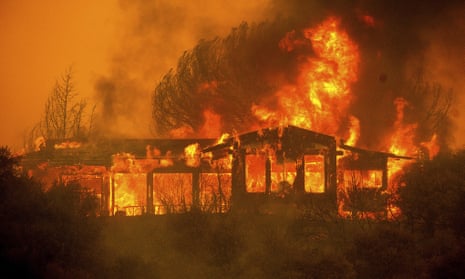There’s been an enormous increase in the number of people at risk from wildfire in the western US in recent decades, with an estimated 6.7m homes now at significant risk from fires that are getting larger and more frequent.
The population in wildfire-prone areas in California, Washington state, Oregon, Idaho and Nevada has exploded since 1940, when just 607,000 houses were in locations threatened by wildfires. The at-risk number of properties in the western US has grown since that time by more than 1,000% to 6.7m, according to recent research.
The findings come as California is scorched by its largest wildfire on record, which has grown to more than 1,176 sq km (454 sq miles). There are seven other major fires in the state, causing several deaths and the deployment of more than 14,000 firefighters.
“It’s a two-headed dragon where we’ve seen an increase in the number of large wildfires and a big increase in population in the worst wildfire areas,” said Stephen Strader, assistant professor of physical and environmental geography at Villanova University and author of the research. “We see everywhere that cities are enlarging, people are spreading out from the urban core.
“In California, this growth is concentrated in areas prone to fire. The west is continuing to grow because of westward migration so this trend is going to continue,” Strader added.
Last year, California’s population grew by nearly 300,000 people in 12 months, bringing it up to nearly 40 million people. Idaho was the fastest growing state for population last year, according to the US Census, with Washington, Oregon, Nevada, Utah and Arizona also experiencing large increases.
At the same time, the number of large conflagrations in the west is climbing. Huge fires more than 1,000 acres in size are now more than 550% more frequent than in the 1970s and early 1980s. The fire season is growing in length due to warming temperatures, providing greater opportunity for dry vegetation to catch light.
“Back in the 1940s, wildfires weren’t as big of a concern because there weren’t many people living in vulnerable areas,” said Strader. “Now you have mountainous areas that are becoming brand new sub divisions for communities. People with money are moving into beautiful regions and are finding that they are getting wildfires.
“We are getting better at mitigating wildfires but that hasn’t really kept pace with the spread of cities. The cost is going up and up.”
Some elected officials have advocated for changes to fire management techniques such as “thinning” out forests to get rid of dead, fire-prone trees.
The US Forest Service has said, however, that fuel reduction activities aren’t sufficient to keep pace with the changes under way due to climate change.
“There is no magic bullet to fix this issue,” said Strader. “There needs to be locally-driven fire programs, new building codes and more resilient homes. We sit idly by time and time again and we get disaster amnesia. We have to take some responsibility and think more about the risk of buying a home in a wildfire prone area, just like we need to think about the flooding risk on the coasts.”
